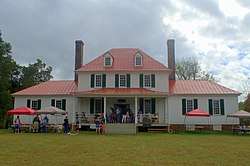Eppington
|
Eppington | |
 Front of the house, pictured in 2017 | |
  | |
| Location | South of the junction of VA 621 and 602, near Winterpock, Virginia |
|---|---|
| Coordinates | 37°17′45″N 77°43′37″W / 37.29583°N 77.72694°WCoordinates: 37°17′45″N 77°43′37″W / 37.29583°N 77.72694°W |
| Area | 1,750 acres (710 ha) |
| Built | c. 1768 |
| Architectural style | Georgian |
| NRHP reference # | 69000230[1] |
| VLR # | 020-0025 |
| Significant dates | |
| Added to NRHP | November 12, 1969 |
| Designated VLR | September 9, 1969[2] |
Eppington is a historic plantation house located near Winterpock, Chesterfield County, Virginia. It was built about 1768, and consists of a three-bay, 2 1/2-story, central block with hipped roof, dormers, modillion cornice, and flanking one-story wings in the Georgian style. It has a later two-story rear ell. It features two tall exterior end chimneys which rise from the roof of the wings. Its builder, Francis Eppes, was brother-in-law and first cousin of Martha Jefferson (1748–1782), the wife of Thomas Jefferson. After her death, Eppes and his wife raised Jefferson's two daughters, while their father was Minister to France. Charles Eppes sent samples of American trees, including Bald Cypress, Eastern Red Cedar, Southern Magnolia and Wax-myrtle as well as hams from Monticello to Thomas Jefferson in France at Thomas Jefferson's request. Daughters of the Eppes studied natural and agricultural sciences, noting what times of year crops came in as well as when Eastern whip-poor-wills arrived and started singing.[3] One of the daughters, Lucy Elizabeth, died in 1784 and was buried at Eppington. Mary (Polly) Jefferson (1778–1804), married in 1797 her cousin, John Wayles Eppes (1772–1823) and spent much of her time at Eppington.[4]
In 1790, Charles Eppes had 124 slaves and 2 white overseers living on Eppington.[3] The yard near the house was a service yard, an area for the house slaves to do work such as smoking country ham, milking cows, churning butter and drawing water from a well. A fence line appears to have kept the field slaves separate from house slaves. The service yard was hidden from visitors with tended gardens, orchards and lawns. The value of the slave's labor added greatly to the wealth of the plantation until the American Civil War.[5] As early as 1806, a school building was on the property. Later, by the mid-eighteen hundreds, the building was converted into a kitchen to replace a previous building that had been the kitchen.[6]

Archibald Thweatt acquired Eppington over several purchases starting on December 1812.[3] Epps Falls, at Eppington, were deemed dangerous for passing boats by the Virginia General Assembly. The General Assembly, in 1819, gave Archibald Thweatt, owner of Eppington, compensation from any damages but allowed the Upper Appomattox Canal company to build a dam and locks around the falls. Archibald Thweatt and his heirs were also given leave to build a grist mill on the dam.[7] Archibald Thweatt raised Merino wool. Also, in 1819, he made a land arrangement which was critical to keep open the right of way road from Richmond to Petersburg.[3]
When the Upper Appomattox Canal Navigation System was complete, neighboring farmers could ship farm produce from the docks at Eppington.[8] There were large loading facilities. When coal was first mined at the Clover Hill Pits, in 1837, it was taken by mule, later by rail, to the docks at Epps Falls. A boat that could carry seven tons of coal, made a four-day round trip to Petersburg for two dollars and thirty eight cents. Rail Service to the docks was discontinued when the Clover Hill Railroad was built to the James River. But it was latter added back when the successor, the Brighthope Railway was expanded in 1881.[9]

It was listed on the National Register of Historic Places in 1969.[1]
References
- 1 2 National Park Service (2010-07-09). "National Register Information System". National Register of Historic Places. National Park Service.
- ↑ "Virginia Landmarks Register". Virginia Department of Historic Resources. Retrieved 5 June 2013.
- 1 2 3 4 McCartney, Martha (February 1994). A Documentary History of Eppington (PDF) (Report). Carlton Abort and Partners,P.C. pp. 36–39, 50–51, 71–76. Retrieved October 7, 2017.
- ↑ Virginia Historic Landmarks Commission Staff (July 1969). "National Register of Historic Places Inventory/Nomination: Eppington" (PDF). Virginia Department of Historic Resources. and Accompanying photo
- ↑ Luccketti, Nicholas; Kelso, William (February 2, 1994). Test Excavations at Eppington Plantation, Chesterfield County (PDF) (Report). James River Institute for Archaeology. pp. 64–68. Retrieved October 7, 2017.
- ↑ Cline, Jason (August 21, 2001). Additional Archaeological Investigations at Eppington Plantation, Chesterfield Virginia (PDF) (Report). William and Mary Center for Archaeological Research, William and Mary College. pp. 10–11. Retrieved October 7, 2017.
- ↑ Acts Passed at a General Assembly of the Commonwealth of Virginia. 1819. pp. 195–.
- ↑ Stith, M.D. (August 23, 1989). "Eppington: Crown Jewel of Chesterfield County" (PDF). Eppington Foundation. Eppington Foundation. Retrieved 2017-01-25.
- ↑ Gerald P. Wilkes (1988). MINING HISTORY OF THE RICHMOND COALFIELD OF VIRGINIA (PDF) (Report). VIRGINIA DIVISION OF MINERAL RESOURCES PUBLICATION 85. p. 10,29–30. Retrieved 2017-01-25.

